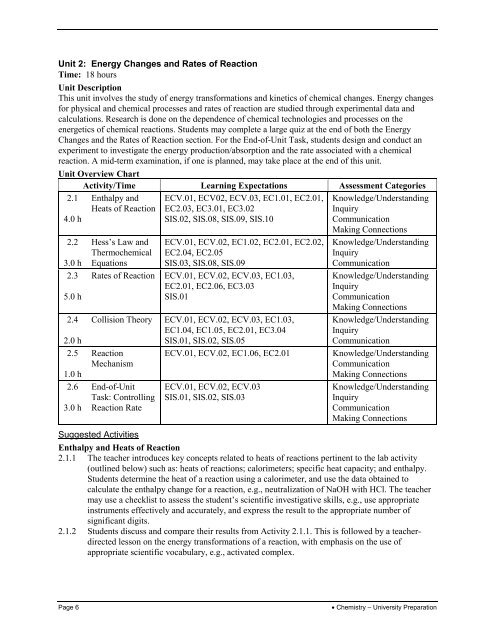Course Profile - Curriculum Services Canada
Course Profile - Curriculum Services Canada
Course Profile - Curriculum Services Canada
Create successful ePaper yourself
Turn your PDF publications into a flip-book with our unique Google optimized e-Paper software.
Unit 2: Energy Changes and Rates of Reaction<br />
Time: 18 hours<br />
Unit Description<br />
This unit involves the study of energy transformations and kinetics of chemical changes. Energy changes<br />
for physical and chemical processes and rates of reaction are studied through experimental data and<br />
calculations. Research is done on the dependence of chemical technologies and processes on the<br />
energetics of chemical reactions. Students may complete a large quiz at the end of both the Energy<br />
Changes and the Rates of Reaction section. For the End-of-Unit Task, students design and conduct an<br />
experiment to investigate the energy production/absorption and the rate associated with a chemical<br />
reaction. A mid-term examination, if one is planned, may take place at the end of this unit.<br />
Unit Overview Chart<br />
Activity/Time Learning Expectations Assessment Categories<br />
2.1<br />
4.0 h<br />
2.2<br />
3.0 h<br />
2.3<br />
5.0 h<br />
2.4<br />
2.0 h<br />
2.5<br />
1.0 h<br />
2.6<br />
3.0 h<br />
Enthalpy and<br />
Heats of Reaction<br />
Hess’s Law and<br />
Thermochemical<br />
Equations<br />
Rates of Reaction<br />
Collision Theory<br />
Reaction<br />
Mechanism<br />
End-of-Unit<br />
Task: Controlling<br />
Reaction Rate<br />
ECV.01, ECV02, ECV.03, EC1.01, EC2.01,<br />
EC2.03, EC3.01, EC3.02<br />
SIS.02, SIS.08, SIS.09, SIS.10<br />
ECV.01, ECV.02, EC1.02, EC2.01, EC2.02,<br />
EC2.04, EC2.05<br />
SIS.03, SIS.08, SIS.09<br />
ECV.01, ECV.02, ECV.03, EC1.03,<br />
EC2.01, EC2.06, EC3.03<br />
SIS.01<br />
ECV.01, ECV.02, ECV.03, EC1.03,<br />
EC1.04, EC1.05, EC2.01, EC3.04<br />
SIS.01, SIS.02, SIS.05<br />
ECV.01, ECV.02, EC1.06, EC2.01<br />
ECV.01, ECV.02, ECV.03<br />
SIS.01, SIS.02, SIS.03<br />
Knowledge/Understanding<br />
Inquiry<br />
Communication<br />
Making Connections<br />
Knowledge/Understanding<br />
Inquiry<br />
Communication<br />
Knowledge/Understanding<br />
Inquiry<br />
Communication<br />
Making Connections<br />
Knowledge/Understanding<br />
Inquiry<br />
Communication<br />
Knowledge/Understanding<br />
Communication<br />
Making Connections<br />
Knowledge/Understanding<br />
Inquiry<br />
Communication<br />
Making Connections<br />
Suggested Activities<br />
Enthalpy and Heats of Reaction<br />
2.1.1 The teacher introduces key concepts related to heats of reactions pertinent to the lab activity<br />
(outlined below) such as: heats of reactions; calorimeters; specific heat capacity; and enthalpy.<br />
Students determine the heat of a reaction using a calorimeter, and use the data obtained to<br />
calculate the enthalpy change for a reaction, e.g., neutralization of NaOH with HCl. The teacher<br />
may use a checklist to assess the student’s scientific investigative skills, e.g., use appropriate<br />
instruments effectively and accurately, and express the result to the appropriate number of<br />
significant digits.<br />
2.1.2 Students discuss and compare their results from Activity 2.1.1. This is followed by a teacherdirected<br />
lesson on the energy transformations of a reaction, with emphasis on the use of<br />
appropriate scientific vocabulary, e.g., activated complex.<br />
Page 6<br />
• Chemistry – University Preparation
















